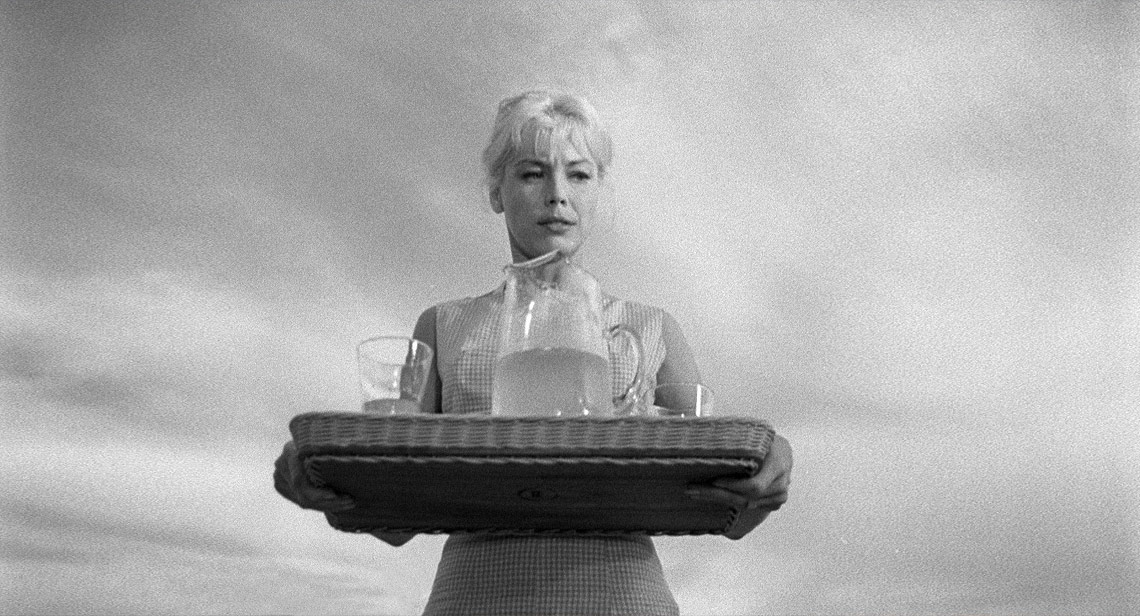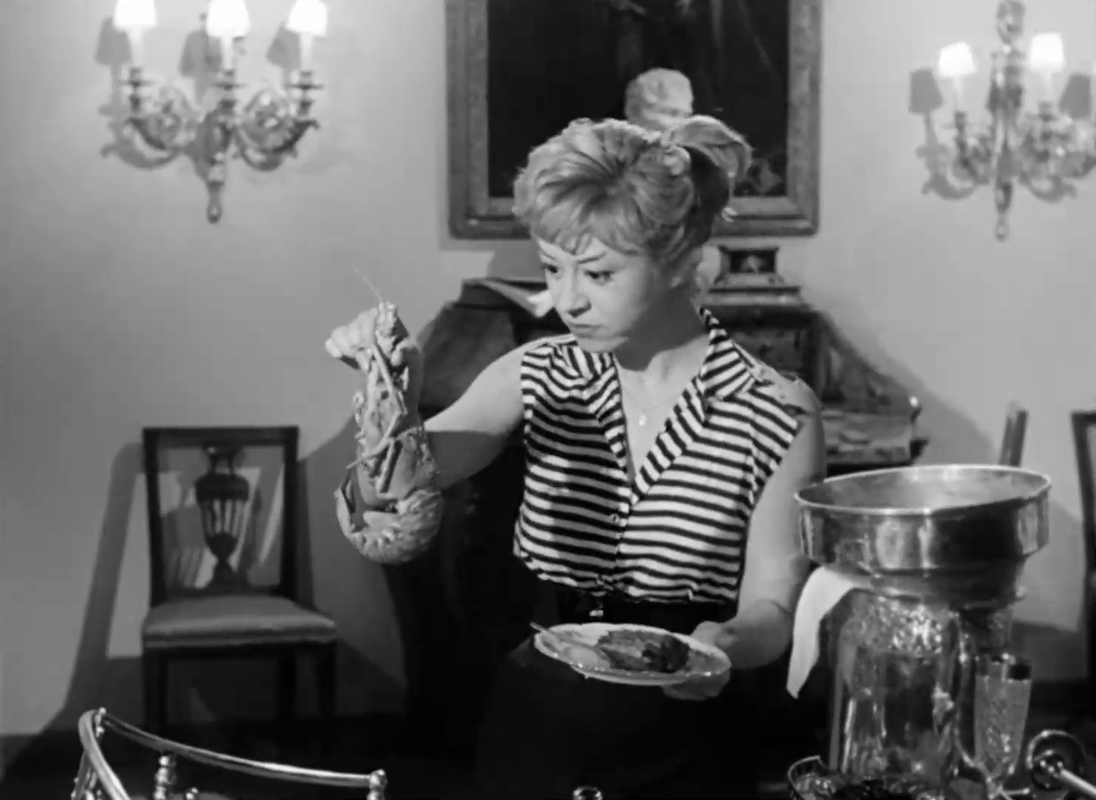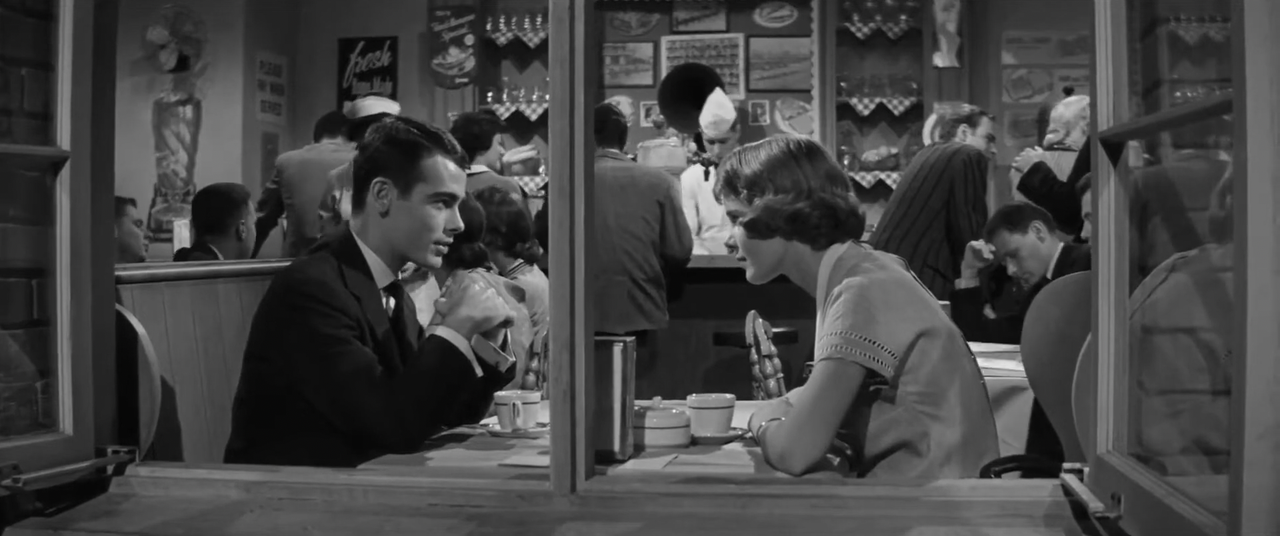– He's got a calendar in there.
– What day is it?
– It's a broad in a cowboy hat.
– Scooby doo bi doo ba ba.Private Property (Leslie Stevens, 1959/1960)
Jul
21

Duke (Corey Allen) and Boots (Warren Oates) “watching TV”. Ann Carlyle (Kate Manx) stripping for her husband is on. DP: Ted D. McCord.
Date watched, not the date in the movie. The quote was too good to leave it off this blog.
1950s
“You know how much coffee I've had today? 17 cups. The Brazilians ought to give me a medal.”The Sniper (Edward Dmytryk, 1952)
Jul
21
chow mein

Dr. James G. Kent (Richard Kiley) discussing the case during lunch at a Chinese restaurant. After scratching his temple with his chopsticks, he attempts to eat his noodles with the utensils' grip. DP: Burnett Guffey.
– ER doctor
“I'm looking for the Hitchcock residence.”Private Property (Leslie Stevens, 1960)
Jul
20
lemonade

A blonde lady (Kate Manx) holds a wicker ray with a pitcher of lemonade and several glasses. Her anxious look contrast with the carefree promise of summer sky and cool drinks. DP: Ted D. McCord.
– Duke
“And what's this? I saw it in a movie once.”Le notti di Cabiria [Nights of Cabiria] (Federico Fellini, 1957)
Jul
18
National Caviar Day

Cabiria (Giulietta Masina) about to experience an unforgettable meal of lobster and caviar. She's holding the lobster up by its antennae with a mix of bewilderment and amusement on her face. Her frumpy outfit looks completely out of place in Lazzari's (Amedeo Nazzari) fancy apartment. DP: Aldo Tonti.
Maria “Cabiria“ Ceccarelli (Giulietta Masina), a prostitute looking for happiness, meets famous movie star Alberto Lazzari (handsomely moustachioed Amedeo Nazzari). In his plush mansion, he treats her to an opulent – if not bewildering to Cabiria – meal of lobster and caviar.
– Cabiria
Co-written by #Pasolini, #Fellini's Le notti di Cabiria is a love letter to hope, life, #Rome, and of course his Giulietta.
“Stop to eat every 8 hours. Just sandwiches.”Plunder Road [The Violent Road] (Hubert Cornfield, 1957)
Jul
10
sandwiches

At a diner, a dark-haired waitress holds up a carafe with fresh coffee and a take-away cup. A man in the background appears to keep an eye on her. DP: Ernest Haller.
“Above all… don’t cut a single image.”Araya [Araya l'enfer du sel] (Margot Benacerraf, 1959)
Jul
5
Venezuela Independence Day

Workers in front of pyramid-shaped piles of salt. DP: Giuseppe Nisoli.
– Jean Renoir in a letter to Margot Benacerraf
“Europe, a Stutz Bearcat, the best restaurants. You fellas really have a hard life, don't you?”Compulsion (Richard Fleischer, 1959)
Jun
29
coffee

A squeaky young Stockwell and Varsi at a diner. We're looking in from the outside through an open window. The place is busy but she's all enthralled by his wit and intellect (and looks for sure). DP: William C. Mellor.
– Harold Horn, DA
“He's still alive.”Muerte de un ciclista [Death of a Cyclist / Age of Infidelity] (Juan Antonio Bardem, 1955)
Jun
28
National Insurance Awareness Day

Juan (Alberto Closas) looking out at María José (Lucia Bosè) and the car after the crash. The cyclist is never shown. The scene echoes Beckett's Waiting for Godot. DP: Alfredo Fraile.
A car crash on National Insurance Awareness Day (USA)
A couple rushing home at night hit a cyclist. Despite knowing that the man's still alive, they opt to leave the site of the #crash and never mention it again. News reports about the death of the cyclist cause a rupture; because of the couple's #class differences – she a wealthy socialite, he a former falange soldier turned university professor – because they're lovers, and because no one can know about their whereabouts on the night of the accident.
Striking about Bardem's Muerte de un ciclista is its outsiderness in the Spanish film landscape. By adopting the visual language of both Italian #Neorealismo and Hollywood #melodrama, Bardem elegantly circumvents #Francoist censorship.
“I don't care about your barley. Or, your vines! Or, your new terra!”Stromboli (Terra di Dio) [Stromboli] (Roberto Rossellini, 1950)
Jun
27
tuna (fresh)

Karen (Ingrid Bergman) looking miserable at a small kitchen table. A huge tuna covers most of its surface. DP: Otello Martelli.
Posted while deciding on my film dinner. Eventually I went with Tourneur's La Main du Diable (1943).
– Karen
“Here we are, poor wretches, in this hell, Condemned to tyranny.” Stromboli (Terra di Dio) [Stromboli] (Roberto Rossellini, 1950)
Jun
27
Decide To Be Married Day

Antonio (Mario Vitale) and Karen (Ingrid Bergman). DP: Otello Martelli.
Karen – “Karin” in the opening credits – is a displaced Lithuanian woman in an Italy-based refugee camp. She meets an Italian military man bivouacking on the other side of the barbed wire and decides to say yes when he proposes. When the newly-weds leave for home, she finds to her dismay that he's a poor Sicilian fisherman from #Stromboli; a magnificent active volcanic island home to a small Catholic parish. Again displaced, Karen is confronted with herself more than with the others that share her faith.
– Antonio
Roberto #Rossellini's Stromboli (Terra di Dio) is a peculiar melodramatic Italian/American hybrid that seems to strongly dismiss the Italian aspect. The significance of Struògnuli – the Sicilian name for the volcano – and the people's faith connected to the volatile mountain and the surrounding sea is presented as primitive superstition. That the Sicilian dialogue – song, prayer, life – remains untranslated and the locals' broken English is used as comic relief adds insult to injury.
Otello Martelli's photography excels when he manages to tear himself away from Bergman's face. Only when we're confronted with the magnificence of Struògnuli, the gifts from the ocean, and the greatness of nature we'll be able to understand why the island is man's home.